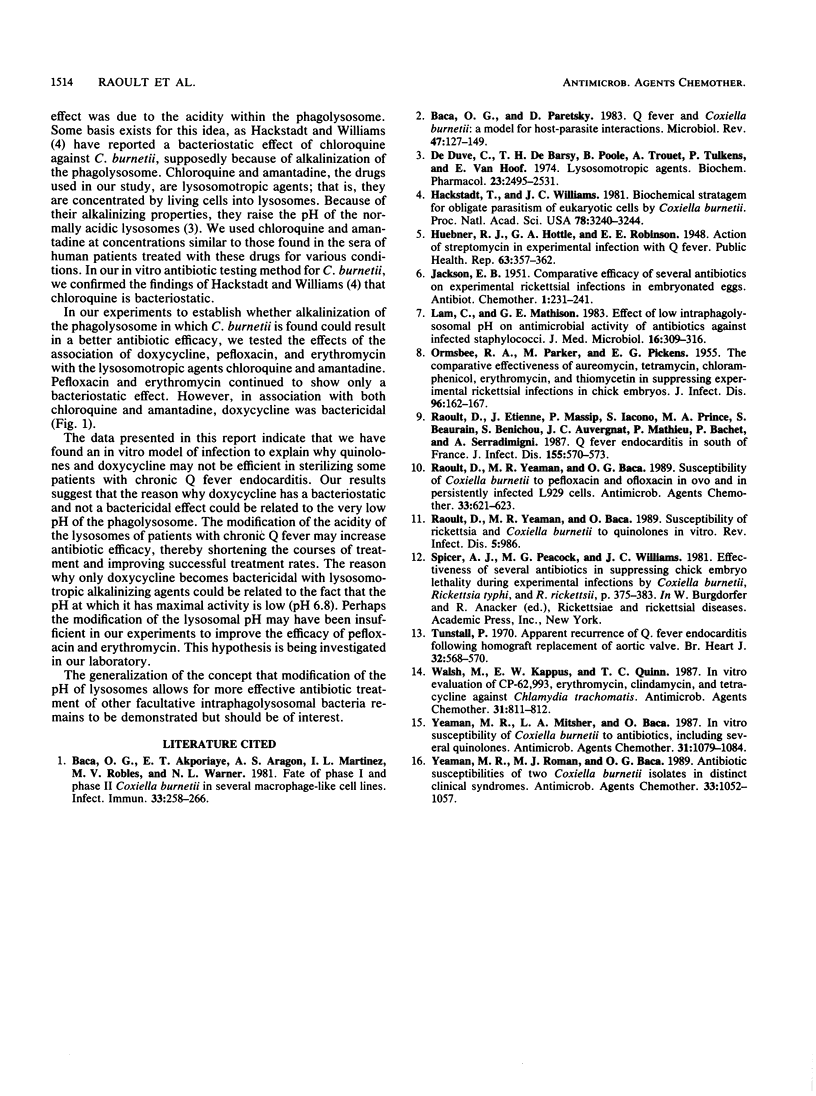Abstract
There is no consistently reliable treatment for endocarditis resulting from chronic Coxiella burnetii infection, the causative agent of Q fever. Although certain antibiotics are recommended on the basis of their in vitro bactericidal activities, results of therapy with these antibiotics are often disappointing. To evaluate whether the currently recommended antibiotic susceptibility tests for C. burnetii give misleading results because of continued division of uninfected cells, thereby resulting in the dilution of infected cells and, hence, a false picture of antibiotic efficacy, we blocked cell division during antibiotic susceptibility testing with cycloheximide. Using this new method, we found that the currently recommended antibiotics for the treatment of Q fever, doxycycline, pefloxacin, and rifampin, did not reduce the ratio of infected to noninfected cells (either L929 or P388D1) by 9 days postinfection. To test the hypothesis that this lack of antibacterial activity is due to antibiotic inactivation by the low pH of the phagolysosomes in which C. burnetii is found, we used alkalinizing lysosomotropic agents (chloroquine or amantadine) concurrently with doxycycline. This resulted in the sterilization of C. burnetii infection in P388D1 cells. This finding seems to confirm our suspicion that the acidic conditions of the phagolysosomes in which C. burnetii is located inhibit antibiotic activity. This inhibition can be reversed in vitro when lysosomotropic alkalinizing agents are used.
Full text
PDF


Selected References
These references are in PubMed. This may not be the complete list of references from this article.
- Baca O. G., Akporiaye E. T., Aragon A. S., Martinez I. L., Robles M. V., Warner N. L. Fate of phase I and phase II Coxiella burnetii in several macrophage-like tumor cell lines. Infect Immun. 1981 Jul;33(1):258–266. doi: 10.1128/iai.33.1.258-266.1981. [DOI] [PMC free article] [PubMed] [Google Scholar]
- Baca O. G., Paretsky D. Q fever and Coxiella burnetii: a model for host-parasite interactions. Microbiol Rev. 1983 Jun;47(2):127–149. doi: 10.1128/mr.47.2.127-149.1983. [DOI] [PMC free article] [PubMed] [Google Scholar]
- HUEBNER R. J., HOTTLE G. A., ROBINSON E. B. Action of streptomycin in experimental infection with Q fever. Public Health Rep. 1948 Mar 19;63(12):357–362. [PMC free article] [PubMed] [Google Scholar]
- Hackstadt T., Williams J. C. Biochemical stratagem for obligate parasitism of eukaryotic cells by Coxiella burnetii. Proc Natl Acad Sci U S A. 1981 May;78(5):3240–3244. doi: 10.1073/pnas.78.5.3240. [DOI] [PMC free article] [PubMed] [Google Scholar]
- Lam C., Mathison G. E. Effect of low intraphagolysosomal pH on antimicrobial activity of antibiotics against ingested staphylococci. J Med Microbiol. 1983 Aug;16(3):309–316. doi: 10.1099/00222615-16-3-309. [DOI] [PubMed] [Google Scholar]
- ORMSBEE R. A., PARKER H., PICKENS E. G. The comparative effectiveness of aureomycin, terramycin, chloramphenicol erythromycin, and thiocymetin in suppressing experimental rickettsial infections in chick embryos. J Infect Dis. 1955 Mar-Apr;96(2):162–167. doi: 10.1093/infdis/96.2.162. [DOI] [PubMed] [Google Scholar]
- Raoult D., Etienne J., Massip P., Iaocono S., Prince M. A., Beaurain P., Benichou S., Auvergnat J. C., Mathieu P., Bachet P. Q fever endocarditis in the south of France. J Infect Dis. 1987 Mar;155(3):570–573. doi: 10.1093/infdis/155.3.570. [DOI] [PubMed] [Google Scholar]
- Raoult D., Yeaman M. R., Baca O. G. Susceptibility of Coxiella burnetii to pefloxacin and ofloxacin in ovo and in persistently infected L929 cells. Antimicrob Agents Chemother. 1989 May;33(5):621–623. doi: 10.1128/aac.33.5.621. [DOI] [PMC free article] [PubMed] [Google Scholar]
- Tunstall Pedoe H. D. Apparent recurrence of Q fever endocarditis following homograft replacement of aortic valve. Br Heart J. 1970 Jul;32(4):568–570. doi: 10.1136/hrt.32.4.568. [DOI] [PMC free article] [PubMed] [Google Scholar]
- Walsh M., Kappus E. W., Quinn T. C. In vitro evaluation of CP-62,993, erythromycin, clindamycin, and tetracycline against Chlamydia trachomatis. Antimicrob Agents Chemother. 1987 May;31(5):811–812. doi: 10.1128/aac.31.5.811. [DOI] [PMC free article] [PubMed] [Google Scholar]
- Yeaman M. R., Mitscher L. A., Baca O. G. In vitro susceptibility of Coxiella burnetii to antibiotics, including several quinolones. Antimicrob Agents Chemother. 1987 Jul;31(7):1079–1084. doi: 10.1128/aac.31.7.1079. [DOI] [PMC free article] [PubMed] [Google Scholar]
- Yeaman M. R., Roman M. J., Baca O. G. Antibiotic susceptibilities of two Coxiella burnetii isolates implicated in distinct clinical syndromes. Antimicrob Agents Chemother. 1989 Jul;33(7):1052–1057. doi: 10.1128/aac.33.7.1052. [DOI] [PMC free article] [PubMed] [Google Scholar]
- de Duve C., de Barsy T., Poole B., Trouet A., Tulkens P., Van Hoof F. Commentary. Lysosomotropic agents. Biochem Pharmacol. 1974 Sep 15;23(18):2495–2531. doi: 10.1016/0006-2952(74)90174-9. [DOI] [PubMed] [Google Scholar]


